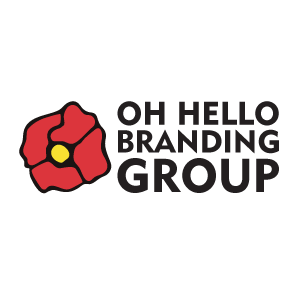Oh, Hello Branding Group
In marketing, social media platforms are powerful tools to generate leads. You’re probably already familiar with the most popular ones, including Instagram, Facebook, and Twitter, but not as many people are utilizing LinkedIn. If you aren’t already including LinkedIn in your lead generation strategy, you might be missing out on a huge opportunity to grow both your brand recognition and revenue, particularly if you’re a B2B business. Research in 2020 showed that LinkedIn is the top platform for paid and organic social channels for B2B businesses.
When you think about the native users of the platforms, this makes complete sense. The average Instagram user quickly scrolls through their feed, viewing photos of their friends, viewing their favorite influencer or celebrity’s Story, or occasionally using the platform to buy products.
LinkedIn on the other hand is specifically for professionals, whether they are searching for a job, trying to strengthen their own brand, or trying to grow their business. If there are already professionals on LinkedIn trying to grow their business, why wouldn’t you go to LinkedIn to help them do exactly that?
LinkedIn can sometimes be overwhelming, especially if you don’t have a specific strategy. Here is a step by step guide to use LinkedIn as a lead generation strategy.

LinkedIn Lead Generation Strategy
Lead generation refers to all of the activities and strategies you use to attract potential customers. This is an absolutely crucial part of your sales process because when you nurture potential customers, they can convert to paying customers that use your products or services and drive revenue.
1. Establish a strong LinkedIn presence for your executives
When you are first starting to use LinkedIn as a lead generator, it can be tricky to know what to do first. Do you start by creating a LinkedIn Company page for your business and begin posting content there? Or do you start posting any new job openings and attract promising talent?
Before you get too ahead of yourself, the first thing you should focus on is each of your employee’s personal LinkedIn profiles, especially the executive’s profiles. First, do a quick audit of each of your executive’s current LinkedIn presence. Are they involved in any industry or local groups? Are they posting original content or articles? More often than not, your executive’s could probably be more active on LinkedIn to grow your brand’s online presence.
Another misconception is that creating your own posts is the only way to stand out on LinkedIn, and that’s actually not true. Even just liking, commenting, or sharing relevant content will help you show up on other people’s feed and build your network.
2. Utilize your LinkedIn company page
After you’ve made sure your executive’s have an established LinkedIn presence, it’s time to focus on your company page. It’s important to make sure the page is active, with original content, and contributions to conversations that are already happening on LinkedIn.
Your page should tell people what the company does, feature what life is like to work at that company, feature some of your employees, and share thought leadership pieces. You can also share information or articles relating to your industry or local area, to build a local network and contribute to your local community.
For finishing touches, make sure the company’s logo is high res, with a nice banner background image, with all information fields filled out.
3. Post relevant content and company updates
To make sure your page and profile are both strong and established, post various types of content, including video. You can post videos from a company page, not a personal page. However, sharing any industry relevant content can help position you and your company as a knowledgeable authority and establish credibility with potential customers.
When you establish this authority, you’ll naturally begin to develop connections with like-minded professionals, some of which might be in your ideal buyer persona. If you are active on the platform, you’ll regularly come up on their feed and establish a genuine connection, which makes it much easier to initiate further conversation.
When your connections interact with your content, it will share it out to their professional network as well, exposing you to an entirely new audience. Pay close attention to your page analytics to find out what type of content does well and is engaging to your audience.
4. Join LinkedIn groups that your clients and customers are in
LinkedIn is a professional social media platform, but it functions very similarly to other social media platforms as well. Just like on Facebook, users can create groups based on industry interests, and joining these groups will introduce you to many professionals and leaders.
In these groups you can post content and updates to create conversations around relevant topics or even talk about services your company offers. You can also utilize groups to learn more about your target audience. Take note of active members and pay attention to what their common pain points are, and any potential solutions mentioned. This information can be a huge advantage, and it can help you create targeted value propositions when you reach out directly to leads.
5. Use paid products to make sure your content is reaching your intended audience
LinkedIn’s paid campaigns are not as heavily utilized as Facebook or Instagram, but it’s still work exploring. LinkedIn is the top paid and organic channel for B2B businesses, so it’s especially useful if you are marketing your services to other businesses.
Using LinkedIn’s paid ads is just another way of ensuring your campaigns are targeted directly to your audience, again, on the platform where your leads are already on. It’s a win-win.

6. Make sure your sales and marketing teams are in full alignment
There’s been a recent shift in consumer behavior, mostly due to the fact that consumers are doing much more research online ahead of time, and using marketing content to inform their purchasing decisions before even considering reaching out to a sales representative.
Consumers are becoming more and more savvy about the products and services they need and progressing much further in the sales process before they reach out to anyone and say that they are interested.
It’s up to marketers to meet the needs of customers that are in the exploring and investigating phase of the sales process, and then to hand those leads off to the sales team so sales has all of the information and context needed to close the deal.
This is why it’s so important to make sure your sales and marketing teams are completely aligned, with minimal miscommunication. Both teams play equally valuable parts in finding prospects and closing deals, and the lines between sales and marketing are more blurred now than they have ever been before.

7. Leverage connections with current customers and clients
The main feature of LinkedIn is making connections and networking, and this is a huge advantage for lead generation. Connect with your current customers and clients on LinkedIn and get a first hand look at who their industry connections are, because they might be relevant to you as well.
If you already have established relationships with your clients, they might be able to connect you with some of their connections, or refer their connections to you for services, or even just help you learn how to reach other people in your target buyer persona.
LinkedIn requests are typically less pushy or “sales-y” than just cold emailing or cold calling prospects. Potential leads can view your request, read your message, and view your profile before they accept it, which builds a sense of trust before you even start the relationship.
Additionally, when you connect with new leads with a 1st or 2nd connection to your network, you’re using warm outreach. You already know a little bit about them and can immediately add value or share content that they are interested in, which is a win right off the bat.
8. Maintain your presence on the platform
Just like all other social media platforms, you should stay consistent on LinkedIn. Posting an article once every 6 months will not be as advantageous to you as posting consistently and creating a strong presence. You’ll also want to communicate consistently with your leads, “ghosting” them in the middle of a conversation will leave them with a worse impression than if you had never reached out at all.
Using LinkedIn to Attract Your Ideal Buyer Persona
The bottom line is, if you aren’t already using LinkedIn or using it frequently enough, you’re missing out on a huge opportunity to grow your business.
And monitoring your LinkedIn and social media strategy doesn't have to be a full-time endeavor. You can easily work it into your existing routine, read more in our free eBook, How to Monitor Social Media in 10 Minutes a Day.
If you have any questions about building an online LinkedIn presence or how you can use the platform to grow your business, contact us here and we can help you!





Submit a Comment